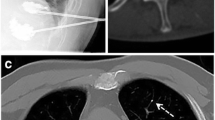Abstract
Background
Metastatic spinal lesions are diseases that impair the quality of life and require early diagnosis and treatment. The count of spinal metastasis patients rises day by day. Increased life expectancy has increased the incidence of cancer, making metastases more observable. The aim of our study was to investigate how the quality of life is affected in the patient group with vertebral fracture due to spinal metastases of multiple myeloma and undergoing vertebroplasty and kyphoplasty.
Materials and methods
Forty-two patients with fracture due to spinal metastasis and adequate follow-up between the years of 2011 and 2018 were included in the study. Patients were listed according to their primary malignancy and metastases. The effect of vertebroplasty and kyphoplasty was investigated by evaluating preoperative and postoperative VAS and Oswestry Disability Index scores. All patients’ radiographic kyphosis angle, compression ratio and wedging index were calculated before operation and after operation.
Results
A total of 76 vertebrae were operated in 42 patients. Significant differences were found in the comparison of preoperative and postoperative quality of life according to VAS and Oswestry Disability Index scores in the patients undergoing vertebroplasty, kyphoplasty or both procedures after spinal metastases (VAS; p = 0.0001, ODI; p = 0.002/0.0001). There were statistically significant differences in preoperative local kyphosis angle, compression ratio and wedging index and post-op local kyphosis angle, compression ratio and wedging index (p = 0.001).
Conclusion
Vertebroplasty and kyphoplasty, minimally invasive procedures performed after spinal metastases, improve the quality of life of the patients.



Similar content being viewed by others
Reference
Melton LJ III, Kyle R (2005) Fracture risk with multiple myeloma: a population-based study. Bone Miner Res 20:487–493
Nelson Astur MM (2019) Balloon kyphoplasty in the treatment of neoplastic spine lesions: a systematic review. Global Spine J 9:348–356
Fourney DR, Schomer D (2003) Percutaneous vertebroplasty and kyphoplasty for painful vertebral body fractures in cancer patients. J Neurosurg 98:21–30
Anselmetti GC, Manca A, Tutton S et al (2013) Percutaneous vertebral augmentation assisted by PEEK implant in painful osteolytic vertebral metastasis involving the vertebral wall: experience on 40 patients. Pain Phys 16(4):E397–E404
Kirkegaard AO, Sørensen T (2018) Percutaneous vertebroplasty is safe and effective for cancer-related vertebral compression fractures. Dan Med J 65(10):A5509-13
Mehdi A, Mansouri N (2019) Use of cement-augmented percutaneous pedicular screws in the management of multifocal tumoral spinal fractures. Asian Spine J 13:305–312
Cho JH, Ha JK (2015) Patterns of treatment for metastatic pathological fractures of the spine: the efficacy of each treatment modality. Clin Orthop Surg 7:476–482
Hirabayashi H, Ebara S (2003) Clinical outcome and survival after palliative surgery for spinal metastases: palliative surgery in spinal metastases. Cancer 97:476–84
Kwon YM, Kim KS (2009) Survival rate and neurological outcome after operation for advanced spinal metastasis (Tomita's classification > or = type 4). Yonsei Med J 50:689–96
Yamashita T, Aota Y (2008) Changes in physical function after palliative surgery for metastatic spinal tumor: association of the revised Tokuhashi score with neurologic recovery. Spine 33:2341–6
Rao PJ, Thayaparan GK (2014) Minimally invasive percutaneous fixation techniques for metastatic spinal disease. Orthop Surgery 6:187–95
Kim CH, Chung CK (2003) Less invasive palliative surgery for spinal metastases. J Surg Oncol 108:499–503
Rastogi R, Patel T (2010) Vertebral augmentation for compression fractures caused by malignant disease. J Natl Compr Canc Netw 8:1095–102
Park HY, Lee SH (2015) Minimally invasive option using percutaneous pedicle screw for instability of metastasis involving thoracolumbar and lumbar spine: a case series in a single center. J Korean Neurosurg Soc 57:100–107
Kim CH, Chung CK (2013) Less invasive palliative surgery for spinal metastases. J Surg Oncol 108:499–513
Frankel BM, Jones T (2007) Segmental polymethylmethacrylate- augmented pedicle screw fixation in patients with bone softening caused by osteoporosis and metastatic tumor involvement: a clinical evaluation. Neurosurgery 61:531–537
Ha KY, Min CK (2015) Bone cement augmentation procedures for spinal pathologic fractures by multiple myeloma. J Korean Med Sci 30:88–94
Lim BS, Chang UK (2009) Clinical outcomes after percutaneous vertebroplasty for pathologic compression fractures in osteolytic metastatic spinal disease. J Korean Neurosurg Soc 45:369–74
Farrokhi MR, Nouraei H (2012) The efficacy of percutaneous vertebroplasty in pain relief in patients with pathological vertebral fractures due to metastatic spinal tumors. Iran Red Crescent Med J 14:523–30
Lane JM, Hong R (2004) Kyphoplasty enhances function and structural alignment in multiple myeloma. Clin Orthop 426:49–53
Hentschel SJ, Burton AW (2005) Percutaneous vertebroplasty and kyphoplasty performed at a cancer center: refuting proposed contraindications. J Neurosurg Spine 2:436–440
Bilsky MH, Lis E (1999) The diagnosis and treatment of metastatic spinal tumor. The Oncologist 4:459–469
Zeifang F, Zahlten-Hinguranage A (2005) Long-term survival after surgical intervention for bone disease in multiple myeloma. Ann Oncol 16:222–227
Health Quality Ontario (2016) Vertebral augmentation involving vertebroplasty or kyphoplasty for cancer-related vertebral compression fractures: an economic analysis. Ont Health Technol Assess Ser 16(12):1–34
Funding
No funding.
Author information
Authors and Affiliations
Corresponding author
Ethics declarations
Conflict of interest
No conflict of interest.
Ethical approval
Ethical approval from Gaziantep University Institutional Reviewer Board.
Additional information
Publisher's Note
Springer Nature remains neutral with regard to jurisdictional claims in published maps and institutional affiliations.
Rights and permissions
About this article
Cite this article
Tekin, S.B., Karslı, B., Büyükbebeci, O. et al. How do vertebroplasty and kyphoplasty affect the quality of life of patients with multiple myeloma spinal metastasis?. Eur J Orthop Surg Traumatol 30, 1447–1451 (2020). https://doi.org/10.1007/s00590-020-02721-3
Received:
Accepted:
Published:
Issue Date:
DOI: https://doi.org/10.1007/s00590-020-02721-3




